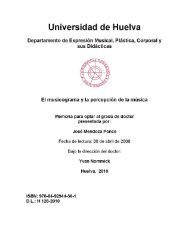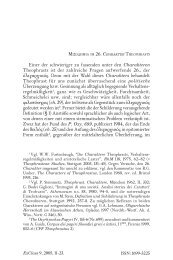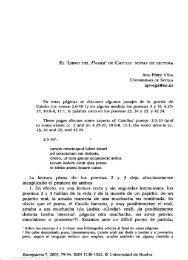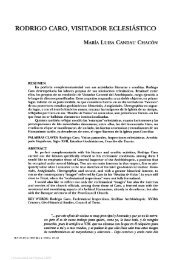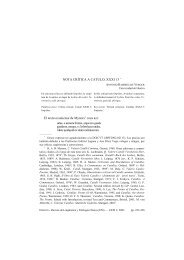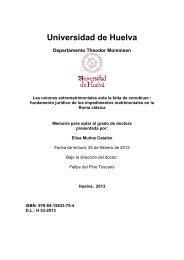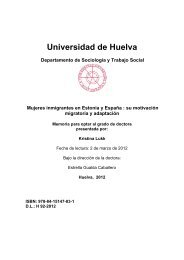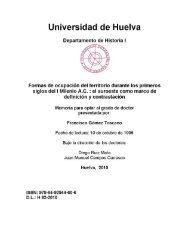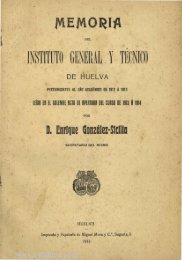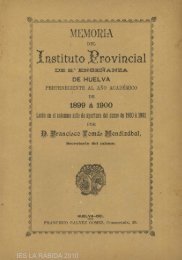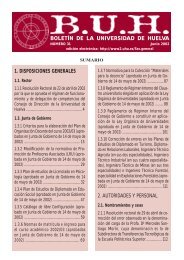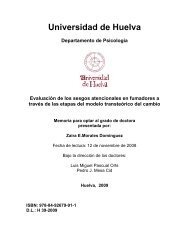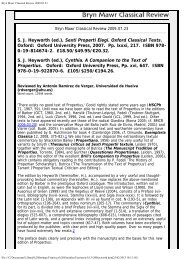: Entre los grandes comentadores de Virgilio, Juan luis de la Cerda ...
: Entre los grandes comentadores de Virgilio, Juan luis de la Cerda ...
: Entre los grandes comentadores de Virgilio, Juan luis de la Cerda ...
You also want an ePaper? Increase the reach of your titles
YUMPU automatically turns print PDFs into web optimized ePapers that Google loves.
196 an d r é s ta b á r e z<br />
<strong>la</strong> <strong>Cerda</strong> había leído a Piero Valeriano 16 . Conocía sin<br />
duda el problema (coges es <strong>la</strong> lectura <strong>de</strong>l Romanus, frente<br />
a <strong>los</strong> otros códices, que traen cogis) y se hal<strong>la</strong>ba por tanto<br />
en condiciones <strong>de</strong> aludir (al menos <strong>de</strong> segunda mano) al<br />
testimonio <strong>de</strong> <strong>los</strong> manuscritos. Sin embargo, <strong>de</strong>jando a un <strong>la</strong>do<br />
el enmarañado ámbito <strong>de</strong> <strong>la</strong> crítica textual, el jesuita se sumerge<br />
en consi<strong>de</strong>raciones puramente literarias (por cierto, finísimas).<br />
Sin duda, intentar separar totalmente <strong>la</strong> ecdótica <strong>de</strong> <strong>la</strong> estilística<br />
es una tarea problemática, y tal vez imposible. Sus ámbitos son<br />
diferentes, pero poseen una <strong>la</strong>rga frontera que <strong>la</strong>s confun<strong>de</strong> 17 . A<br />
este respecto, pue<strong>de</strong> ser interesante comparar <strong>la</strong> nota anterior<br />
con <strong>la</strong> correspondiente entrada <strong>de</strong> C<strong>la</strong>usen ad locum:<br />
mori me <strong>de</strong>nique cogis: Theocr. 3.9. ἀπάγξασθαί<br />
με ποησεῖς, “you will make me hang myself”,<br />
would seem to support coges, but cogis is the<br />
reading of the better MS, less obvious, and more<br />
dramatic—“quasi iam sit mors in oculis” (<strong>la</strong> <strong>Cerda</strong>).<br />
In any case, Virgil was not merely trans<strong>la</strong>ting<br />
Theocritus 18 .<br />
<strong>la</strong>s tres razones que se alu<strong>de</strong>n parecen escalonarse en crescendo:<br />
primero se refiere el testimonio material, luego <strong>la</strong> cualidad <strong>de</strong>l<br />
contenido, por último <strong>la</strong> virtud literaria. En todo caso, “less<br />
obvious” y “more dramatic” son atributos poco estemáticos y<br />
suponen una ve<strong>la</strong>da comparación entre el romano y el griego.<br />
Pero <strong>la</strong> diferencia entre ambos <strong>comentadores</strong> es c<strong>la</strong>ra: para<br />
C<strong>la</strong>usen, el testimonio textual constituye <strong>la</strong> base que permite <strong>la</strong><br />
valoración literaria; en <strong>la</strong> <strong>Cerda</strong> ocurre lo contrario.<br />
ExC<strong>la</strong>ss 13, 2009, 189-196.<br />
an d r é s ta b á r e z<br />
Universitat <strong>de</strong> Barcelona<br />
andrestabarez@hotmail.com<br />
16 El nombre <strong>de</strong> Piero Valeriano aparece consignado en <strong>la</strong> tab<strong>la</strong> <strong>de</strong> autores<br />
recentiores que se presenta en <strong>la</strong>s primeras páginas <strong>de</strong>l comentario.<br />
17 Recuér<strong>de</strong>se <strong>la</strong> formu<strong>la</strong>ción <strong>de</strong> Paul Maas: “el núcleo <strong>de</strong> prácticamente<br />
cualquier problema <strong>de</strong> crítica textual es en el fondo un problema <strong>de</strong> estilo”.<br />
Cf. P. Maas, Textual Criticism (Trad. <strong>de</strong> B. Flower <strong>de</strong> Textkritik, leipzig<br />
1927), london 1958, 40-1.<br />
18 C<strong>la</strong>usen, Eclogues, 66.



